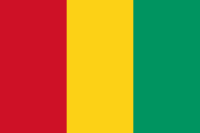 Guinea (pronounced /ˈɡɪni/, officially the Republic of Guinea French: République de Guinée), is a country in West Africa. Formerly known as French Guinea (Guinée française), it is today sometimes called Guinea-Conakry to distinguish it from its neighbor Guinea-Bissau. Conakry is the capital, the seat of the national government, and the largest city.
Guinea (pronounced /ˈɡɪni/, officially the Republic of Guinea French: République de Guinée), is a country in West Africa. Formerly known as French Guinea (Guinée française), it is today sometimes called Guinea-Conakry to distinguish it from its neighbor Guinea-Bissau. Conakry is the capital, the seat of the national government, and the largest city.
Guinea has almost 246,000 square kilometres (94,981 sq mi). It forms a crescent by curving from its western border on the Atlantic Ocean toward the east and the south. Its northern border is shared with Guinea-Bissau, Senegal, and Mali, the southern one with Sierra Leone, Liberia, and Côte d’Ivoire. The Niger River arises in Guinea and runs eastward.
Guinea’s 10,000,000 people belong to twenty-four ethnic groups. The most prominent groups are the Fula, Mandinka, and Susu.
In successive migrations c. 900 CE, the Susu swept down from the desert and pushed the original inhabitants, the Baga, to the Atlantic coast. Small kingdoms of the Susu rose in importance in the 13th century and later extended their rule to the coast. In the mid-15th century the Portuguese visited the coast and developed a slave trade. In the 16th century the Fulani established domination over the Fouta Djallon region; they ruled into the 19th century.
In the early 19th century the French arrived and in 1849 proclaimed the coastal region a French protectorate. In 1895 French Guinea became part of the federation of French West Africa. In 1946 it was made an overseas territory of France, and in 1958 it achieved independence. Following a military coup in 1984, Guinea began implementing Westernized government systems. A new constitution was adopted in 1991, and the first multiparty elections were held in 1993. During the 1990s Guinea accommodated several hundred thousand war refugees from neighbouring Liberia and Sierra Leone, and conflicts between these countries and Guinea have continued to flare up over the refugee population into the early 21st century.
Independence for Guinea came in 1958, and the first major band in the Guinean popular music tradition was formed by the government soon after; this was the Syli Orchestre National, a dance orchestra which featured some of the best musicians in the land. Guinea’s President, Sekou Toure, disbanded all of the private dance orchestras in the country, and created a network of state-sponsored groups throughout the county. Some of the early dance bands included popular groups like Keletigui Et Ses Tambourinis, Balla et ses Balladins, and Kebendo Jazz. Many of these bands recorded on Syliphone records. Bembeya Jazz National further enriched Guinea’s musical melting pot after visiting Cuba in 1965.
As in Mali, a roots revival occurred in the 1960s and 1970s with state support from Sekou Touré. He introduced a radical cultural policy called “authenticite”, whereby musicians and artists were instructed to “look at the past” for inspiration, and to incorporate traditional practices in their arts.
Authenticite ended with the death of Sekou Toure in 1984. Later, Mory Kanté became a big star. Albums like 10 Cola Nuts saw major mainstream success in both Guinea and Mali, as well as some European success. “Yeke Yeke”, however, a single from Mory Kanté à Paris, became a European chart-topper in 1988.
Predominantly agricultural, Guinea produces rice, coffee, pineapples, palm kernels, cassava, bananas, and sweet potatoes. Livestock raising (cattle, sheep, and goats) is important in the highlands. The country has about a third of the world’s bauxite deposits, which are mined jointly by Guinea and international companies. Gold, diamonds, and iron ore are also mined. Minerals account for more than 70% of all exports.
Alumina, made from bauxite, is also a leading export; other exports include fish, coffee, and a variety of agricultural products. The main imports are petroleum products, metals, machinery, transportation equipment, textiles, and grains. Guinea’s chief trading partners are Russia, the United States, France, South Korea, Spain, and Belgium. Guinea has some light industry, but inadequate transportation facilities have hampered industrialization. Rail lines connect some large cities, and there are airports at Conakry and Kankan. Expansion of the mineral industry has led to improvement of the road network.
Notes from Wikipedia and Answers.com









